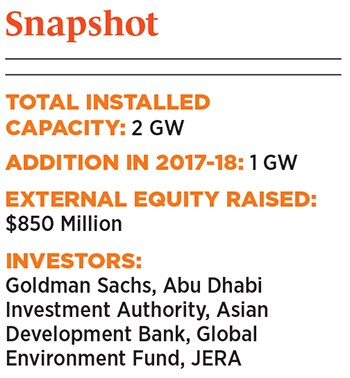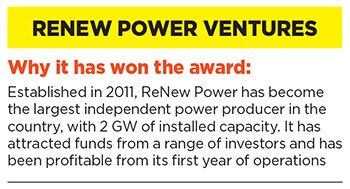ReNew Power Ventures: Impressing investors with outstanding performance
On the back of discipline and fiscal prudence, ReNew Power Ventures has emerged as the largest renewable energy producer in the country
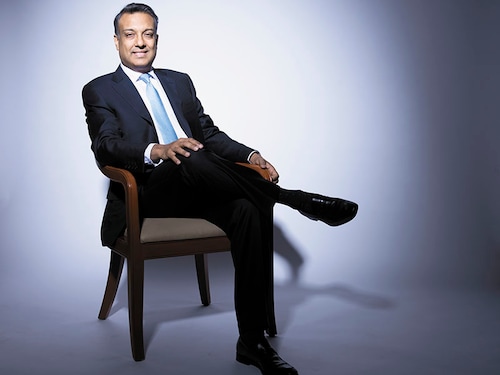

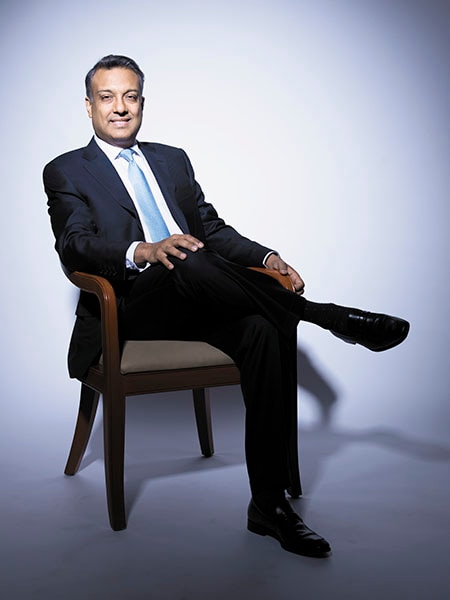 Sumant Sinha, chairman and CEO, ReNew Power
Sumant Sinha, chairman and CEO, ReNew Power
Image: Amit VermaForbes India Leadership Award 2017: Outstanding Startup
But then, when you read page 18, Chapter 4, of Report No. 34 of the Union Civil Performance Renewable Energy Report, prepared by the Comptroller and Auditor General (CAG) of India in 2015, this is what you come across: “It was observed that neither Tamil Nadu Generation and Distribution Corporation Limited (TANGEDCO) nor Tamil Nadu Transmission Corporation Limited (TANTRANSCO) were able to create adequate transmission infrastructure facilities or utilise the existing facilities effectively. During high wind season, the transmission lines were congested leading to problems of voltage stability and power quality… There was no long-term transmission planning process to incorporate transmission and evacuation requirements of wind energy.”
By the time the CAG had made this observation, wind power generators in the state had lost `2,040 crore of revenue between 2007 and 2014. ReNew Power, founded in 2011, lost nothing.
For a startup, not rushing into an area ripe with opportunity is unusual behaviour. But for ReNew Power, it is what defines them. “It was a conscious choice for us not to go into Tamil Nadu,” says Parag Joshi, COO, ReNew Power. “Many times, our investment committee would approve a proposal for a project, but the board of directors was very strict about not investing there. We were aware of the problems, but sometimes you become aggressive when you see the natural potential of the state. But somehow, better sense prevailed.”This better sense—of not rushing in where other players do—has consistently prevailed within ReNew Power where several other projects are concerned.
For instance, ReNew has only one project—about 35 MW, in Gujarat, started in 2012—under the central government’s renewable energy certificate (REC) scheme, where state power utilities have to buy a share of their total power requirement from renewable energy producers. “The REC scheme, at one time, was giving very high internal rate of returns, and everybody [other industry players] were talking about doing their due projects under REC,” says Joshi, 44. However, soon enough, projects under the scheme ran into trouble as state power discoms refused to comply with their renewable purchase obligations (RPO), and there was no mechanism to penalise them. This led to a massive inventory pile-up and losses faced by power generators.
In a performance audit of the country’s renewable energy sector in 2015, the CAG observed that between 2010 and 2014, only 4.77 percent of RPO compliance was through the REC scheme. Under the National Action Plan for Climate Change, the RPO targets were to be 8 and 9 percent for 2012-13 and 2013-14, against which the national achievement was only 4.28 and 4.51 percent, respectively. The CAG blamed “uncertain policy environment and poor RPO enforcement” for the situation.
ReNew also did not invest in open-access projects—where the power generating company sells directly to consumers and not to state discoms—other than in Karnataka. “We sell directly to 40 to 50 customers in Karnataka, because the state government has given a 10-year window within which they will not change any regulations,” explains Joshi. “In other states, they keep changing the open-access policy, the transmission and billing tariffs. Many companies tried to invest in open-access projects in other states, but they proved to be a disaster.”
CFO Ravi Seth, 56, says that the selection of, and bidding for, projects has also been very disciplined in terms of the returns expected: “While operators would like to be very aggressive, our board of directors helped to enforce that discipline, and said, ‘we want to see growth, but we don’t want to see growth at the expense of successful return-oriented profitable growth’. We ensure that we don’t lose our focus from profitability, cash and returns.”
And yet, by 2016, ReNew became the first independent power producer (IPP) in India to have 1 GW of installed capacity. As of now, it has built 2 GW of commissioned assets, with a pipeline of more than 1 GW, to emerge as the country’s largest IPP. It has also been profitable from its first year of operations.
While staying clear of policy uncertainties by way of stringent internal controls has been one way of ensuring profitability, raising money before taking on new projects, and not after, has ensured timely completion. “As part of our financial prudence, we always raise money in advance of making commitments, so we never have fundraising happening post commitments,” says Seth. “We have never been in a situation where we have committed to a project and then gone looking for money. We have ensured that we take care of the next gigawatt, at least, at any point in time.”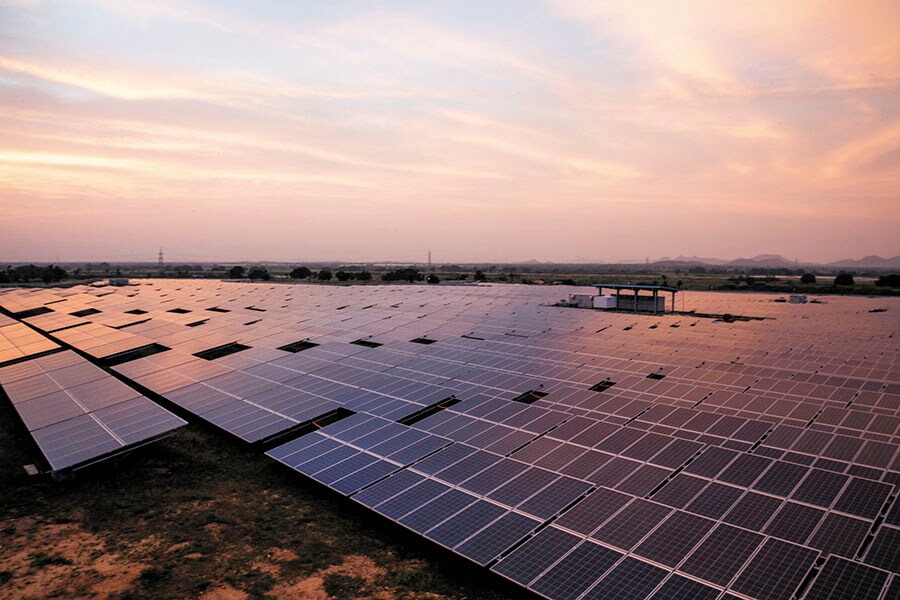 A ReNew Power solar farm outside of Hyderabad
A ReNew Power solar farm outside of Hyderabad
Image: Harsha Vadlamani for Forbes India
This approach has continued into its latest rounds of investments as well, where Jera Co Inc, a joint venture between Tokyo Electric Power Group, Japan’s largest utility, and Chubu Electric Power Group, established in 2015, in February bought a 10 percent stake in ReNew for $200 million, valuing the company at $2 billion. This investment was Jera’s first step into the energy market in India its portfolio of projects include plants in Thailand, Indonesia, Vietnam, the Philippines, Taiwan, Qatar, Oman, the United Arab Emirates, the US, Canada and Mexico. “When we raised the money from Jera, we were clear that these are the [future] investments we are looking at. We were already funded for whatever commitments we have made. This was additional money coming in for our pipeline of projects,” Seth adds.
The increasing push from the central government for promoting renewable energy—in 2015, it revised the installation target to 175 GW by 2022—has been instrumental in the sector receiving investments of $14 billion (debt and equity) in 2016-17, double of what it had received in the previous fiscal. Given these conditions, and its own performance over the last six years, ReNew has expanded its pool of capital. “Funding is much less of an issue than what it was five years ago,” says Seth. “When we started off, it was more about banks or other agencies like Irda, which were providing funds. Since then, a lot of private sector banks also have been providing funding. We have seen L&T Infra that have started putting in money. We started raising money through bonds, but that market is still not as deep as we would like to see it. We also have dollar bonds. So we have a [diverse] pool of capital.”
*********
But this was not how it was when it all had begun.
Somewhere between 2010 and 2011, when Chairman and CEO Sumant Sinha, 52, had decided to turn entrepreneur after a long career in banking, followed by a six-year stint at the Aditya Birla Group and two years as the CFO at wind turbine makers Suzlon Energy, he found himself knocking on a few too many doors. “I must have spoken to about 30 to 35 investors in Mumbai, and they had all turned me down. My plans were too big for venture capitalists to fund, and too early-stage for private equity players,” he remembers. Failure began to look like a distinct possibility. “I was alive to the possibility that it would not work out.” But, he adds, “As an entrepreneur you have to be totally prepared for that.”
“You just have to keep looking and trying,” he continues. “Because you don’t know where that one investor is waiting for you to show up.”
For Sinha, that investor was Goldman Sachs.
Goldman Sachs had invested in a startup platform in wind energy, called Horizon Energy, in the US, which they had scaled to 500 MW and then sold to a strategic investor to get good returns. Meanwhile, they were experiencing some ups and downs in their India business, and had been advised to invest in the renewable power sector. At that time, wind energy was more prevalent in this sector, and because of Goldman Sachs’s US experience, they decided to go down the same path in India, and were looking for startups in the country.
[qt]We have never committed to a project and then gone looking for money. We have ensured that we take care of the next GW.[/qt]
There were other startups in the sector that they were in talks with, but what seems to have swayed their decision in favour of ReNew was Sinha’s experience in both the wind power business and the financial sector.
“ReNew Power, from the outset, had a first-class management team with a strong execution track record, which was very critical for us,” says Ankur Sahu, co-head of Goldman Sachs’s merchant banking division in the Asia Pacific, and a director on ReNew’s board. “As Goldman Sachs invested in the early stages of the company, ReNew offered a great platform for us to shape and execute on the strategy to build a world-class renewables company.”
Goldman Sachs wanted to ensure that Sinha did not have to worry about raising further funds soon, and was free to focus on project execution. Hence, although Sinha was looking to raise about $60-65 million, they approved an amount of $200 million. (In the following years Goldman Sachs has continued investing in renewable energy enterprises across the world, and, in November 2015, announced it would invest more than $150 billion in the sector by 2025.)
Although the funds brought a great sense of relief, they also brought along a sense of responsibility. For now, it was time to actually execute the projects on ground, something that has never been an easy task in India. “When I started off, I was the only guy sitting in a Diner’s Club temporary office then I had a secretary, so there were two of us sitting there,” Sinha says. “From that to here has been a huge journey. Each step of the way you are concerned about whether you can take the next step or not. We had to prove to ourselves and to the investors that we could actually produce megawatts on the ground.”
He recalls, for instance, the difficulty of procuring bank loans after getting Goldman Sachs as an investor in 2011. Public sector banks were familiar with proprietor-owned companies, and a private equity-funded company was a new animal for them. “The banks just wanted to know whose neck they should catch if something went wrong,” he laughs. “I had to convince them that they had to focus on the quality of the management and the functioning of the project.” Or the trouble that their very first project in Gujarat ran into over the power purchase agreement with Gujarat Urja Vikas Nigam Limited, the state’s overall electricity services company.
For the first one or two years, it was just about trying to scale up, accompanied with a fair share of ups and downs. But in 2014, by when ReNew had raised about $350 million, Sinha realised that they could become a billion-dollar company. “To me, that realisation was quite a surprise,” he says. “For a lot of new companies, that is a big target—after getting the first funding—that you want to reach. And not everybody gets there.”
But the trick perhaps was to not think too much about the future, because there were targets to meet in a consistent manner. “I realised that if every step we take is largely in the right direction, and we just focus on taking the next step, then we will be moving in the right direction. There was no point in looking into the distance and thinking, ‘that is where I want to get’, when I don’t know how to cross the next five metres,” he says.
The team that Sinha has built has been key to the progress made by his venture. “The team will have to do everything. You can frame the general direction in which you want to go, you can raise the capital, but ultimately, if the team is not a good team, or you can’t manage them well, or they don’t gel together, then things fall apart.” Sinha thinks he was partly lucky to get some very good team members fairly early on, and that they stayed on. The fact that the company offered an attractive stock option enhanced this stickiness senior managers are also incentivised to make this venture successful. “We have worked together a lot when we were a small company, we have gone through a lot of things together,” Sinha says. This not only helped develop a closeness within the team, but also made them aware of each other’s strengths and weaknesses.
There are three things, Sinha says, that are required to make a great organisation—good people, good systems and processes, and good culture. So although Sinha’s job has been to look for market opportunities and grow the business, it has also been about building the organisation. For, once the systems and processes are in place, the organisation takes care of itself. Sinha feels indebted to the Aditya Birla Group—he started their retail business for them—for showing him how these elements function within a large company, and what are the right ways of implementing them.
The internal strength and performance of the company weighed in where ReNew Power’s recent funding from Jera is concerned. “Mr Sumant Sinha’s excellent leadership and the management team who operate the company, the high quality of existing assets, a robust pipeline for future development opportunities, and swift development with cost competitiveness”, are the attributes that gave Jera the confidence of investing in ReNew Power, Satoshi Yajima, Jera nominee director, wrote over email. Yajima also highlighted the transparency of the company in accounting, and its relationships with shareholders such as Goldman Sachs, Abu Dhabi Investment Authority, Asian Development Bank and Global Environment Fund, as other decisive factors.
Although Sinha’s lessons have come from bigger companies, he would not want to stop thinking like a startup. “There should always be that sense of ownership, the sense of urgency that startups have,” he says. “Having a small company mentality no matter how big a company you are is very important.”
And now, having made the transition from a salaried job to turning entrepreneur, and having built a small company that is well on its way to becoming a bigger one, would he like to do it all over again? Sinha says with a laugh: “I have asked myself that question many times, and have not been able to answer it.”
First Published: Nov 21, 2017, 06:02
Subscribe Now